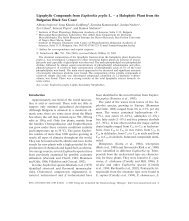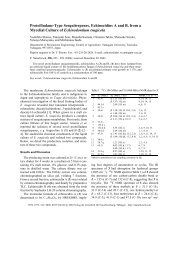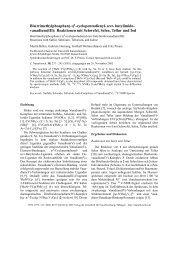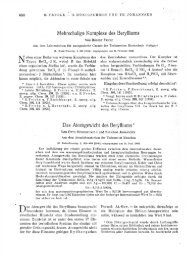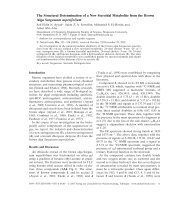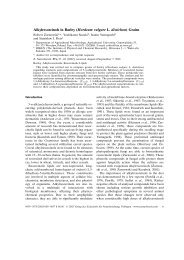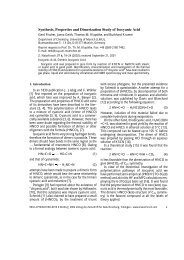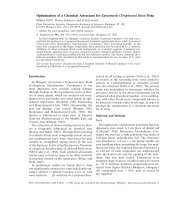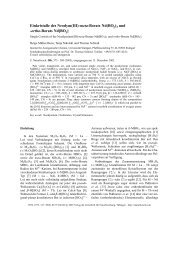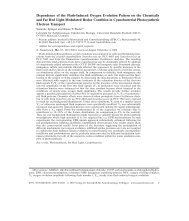Chemical and Biological Investigation of Araucaria heterophylla ...
Chemical and Biological Investigation of Araucaria heterophylla ...
Chemical and Biological Investigation of Araucaria heterophylla ...
You also want an ePaper? Increase the reach of your titles
YUMPU automatically turns print PDFs into web optimized ePapers that Google loves.
<strong>Chemical</strong> <strong>and</strong> <strong>Biological</strong> <strong>Investigation</strong> <strong>of</strong> <strong>Araucaria</strong> <strong>heterophylla</strong>Salisb. ResinEssam Abdel-Sattar a, *, Azza R. Abdel Monem b , Shahira M. Ezzat b ,Ali M. El-Halawany b,c , <strong>and</strong> Samar M. Mouneir daDepartment <strong>of</strong> Natural Products, Faculty <strong>of</strong> Pharmacy, King Abdulaziz University,Jeddah 21589, Kingdom <strong>of</strong> Saudi Arabia. Fax: +9 66-2-6 95 16 96.E-mail: abdelsattar@yahoo.combDepartment <strong>of</strong> Pharmacognosy, Faculty <strong>of</strong> Pharmacy, Cairo University, Cairo 11562,EgyptcDepartment <strong>of</strong> Metabolic Engineering, Institute <strong>of</strong> Natural Medicine,University <strong>of</strong> Toyama, Sugitani 2630, Jap<strong>and</strong>Department <strong>of</strong> Pharmacology, Faculty <strong>of</strong> Veterinary Medicine, Cairo University,Cairo 12211, Egypt* Author for correspondence <strong>and</strong> reprint requestsZ. Naturforsch. 64 c, 819 – 823 (2009); received May 1/June 8, 2009Three labdane diterpenes, namely labda-8(17),14-diene, 13-epicupressic acid, <strong>and</strong> 13-Oacetyl-13-epicupressicacid, were isolated from the resin collected from stem exudates <strong>of</strong><strong>Araucaria</strong> <strong>heterophylla</strong> Salisb. (<strong>Araucaria</strong>ceae). The isolated compounds were identifiedusing different spectroscopic methods ( 1 H NMR, 13 C NMR, HMQC, HMBC <strong>and</strong> COSY).The resin extract showed antiulcerogenic activity against ethanol-induced stomach ulcersin Sprauge Dawely rats using ranitidine as st<strong>and</strong>ard. In addition, the resin <strong>and</strong> the isolatedcompounds showed variable cytotoxic activities against breast (MCF7) <strong>and</strong> colon (HCT116)cancer cell lines.Key words: <strong>Araucaria</strong> <strong>heterophylla</strong>, Labdane Diterpenes, Antiulcerogenic <strong>and</strong> CytotoxicActivitiesIntroduction<strong>Araucaria</strong>ceae (Coniferae) is a small family;it comprises two genera, <strong>Araucaria</strong> <strong>and</strong> Agathis,<strong>and</strong> 38 species <strong>of</strong> trees (Trease <strong>and</strong> Evans, 1978).<strong>Araucaria</strong> <strong>heterophylla</strong> Salisb. Franco (syn. A. excelsa)is a popular columnar tree used as Christmastree (Schans et al., 2004). Diterpenes (Caputo<strong>and</strong> Mangoni, 1974; Caputo et al., 1974a, b; Coxet al., 2007) <strong>and</strong> lignans (Ohashi et al., 1992; Fonsecaet al., 1978, 1979) were isolated from resinexudates <strong>of</strong> different <strong>Araucaria</strong> species includingA. <strong>heterophylla</strong> Salisb. (Caputo et al., 1972). Theresins <strong>of</strong> this genus were reported to possess cytotoxic<strong>and</strong> gastroprotective activities (Lee <strong>and</strong>Cheng, 2001; Schmeda-Hirschmann et al., 2005a,b). In the present study, the resin exudates fromstems <strong>of</strong> A. <strong>heterophylla</strong> Salisb. growing in Egyptas ornamental plant were subjected to chemical<strong>and</strong> biological investigations.Material <strong>and</strong> MethodsPlant materialThe resin exudates from the stems <strong>of</strong> A. <strong>heterophylla</strong>Salisb. were collected from El-MuntazaPalace Garden, Alex<strong>and</strong>ria, Egypt in August 2007.The plant was identified by Mrs. T. Labib, taxonomist<strong>of</strong> Orman Botanical Garden, Giza, Egypt. Aspecimen was deposited in the herbarium <strong>of</strong> OrmanBotanical Garden, Giza, Egypt.General1H NMR (400 MHz), 13 C NMR (100 MHz), <strong>and</strong>2D NMR spectra were measured on a JHA-LAA 400 WB-FT Jeol spectrophotometer. TLCwas performed on precoated silica gel plates usingthe solvent system n-hexane/EtOAc (4:1); thechromatograms were visualized by spraying withanisaldehyde/sulfuric acid spray reagent followedby heating at 110 ºC for 5 min.0939 – 5075/2009/1100 – 0819 $ 06.00 © 2009 Verlag der Zeitschrift für Naturforschung, Tübingen · http://www.znaturforsch.com · D
820 E. Abdel-Sattar et al. · <strong>Chemical</strong> <strong>and</strong> <strong>Biological</strong> <strong>Investigation</strong> <strong>of</strong> <strong>Araucaria</strong> <strong>heterophylla</strong>Extraction <strong>and</strong> fractionationThe resin <strong>of</strong> A. <strong>heterophylla</strong> Salisb. (20 g) wasextracted with CHCl 3 , then with CHCl 3 /MeOH(1:1, 3 × 100 ml for each solvent). The combinedextracts were evaporated under reduced pressure(≤ 60 ºC) to give 15 g <strong>of</strong> a sticky yellow residue.The residue (10 g) was chromatographed on asilica gel G 60 column (7 × 20 cm, VLC) elutedwith n-hexane, n-hexane/CHCl 3 <strong>and</strong> CHCl 3 /MeOH mixtures. Fractions <strong>of</strong> 200 ml each werecollected <strong>and</strong> monitored by TLC. Similar fractionswere pooled together. Fractions 8 – 10 (2.8 g),eluted with n-hexane/CHCl 3 3:7 to 1:9, showedthree major spots. The combined fractions wererechromatographed on successive silica gel columnsusing n-hexane/ethyl acetate mixtures toafford compounds 1 (12 mg), 2 (20 mg), <strong>and</strong> 3(50 mg). The three compounds were isolated asyellow resins.Antiulcerogenic effectSprauge Dawely rats (150 – 200 g body wt.) werekept under st<strong>and</strong>ard hygienic conditions beforeuse. They were fed <strong>and</strong> watered ad libitum. Ratswere r<strong>and</strong>omly divided into 4 equal groups <strong>of</strong> 5rats each. Animals were starved for 48 h beforeuse to ensure an empty stomach <strong>and</strong> were kept incages with raised floors <strong>of</strong> wide wire mesh to preventcorporophagy (Garg et al., 1993). To preventexcessive dehydration during the fasting period,rats were supplied with 0.2% sucrose (BHD)which was removed 1 h before the experiment(Glavin <strong>and</strong> Mikhaeil, 1976). The control groupwas given an equal volume <strong>of</strong> distilled water instead<strong>of</strong> the resin extract, but received ethanolin the same dose <strong>and</strong> route (orally) as the othergroups. In addition, the second group was givenranitidine as a st<strong>and</strong>ard in a dose <strong>of</strong> 100 mg/kgbody wt. orally by a stomach tube. The third <strong>and</strong>fourth groups were orally given the resin extractin doses <strong>of</strong> 100 <strong>and</strong> 200 mg/kg body wt., respectively.On the first day, rats <strong>of</strong> the third <strong>and</strong> fourthgroups were orally given two doses <strong>of</strong> the resinextract with 6 h apart; a third dose was given onthe second day 1.5 h before oral administration<strong>of</strong> ethanol (Merck), 50% (v/v in distilled water),in a dose <strong>of</strong> 10 ml/kg. 1 h after ethanol administration,all rats were euthanized by an overdose<strong>of</strong> chlor<strong>of</strong>orm, their abdomens were opened <strong>and</strong>their stomachs rapidly removed, opened alongtheir greater curvature <strong>and</strong> gently raised underrunning water. Lesions in the gl<strong>and</strong>ular part <strong>of</strong>the stomach were measured under an illuminatedmagnifying microscope (10×). Long lesions werecounted <strong>and</strong> measured along their greater length.Petechial lesions were taken as 1 mm ulcer (Cho<strong>and</strong> Ogle, 1978). The sum <strong>of</strong> the total length <strong>of</strong>long ulcers <strong>and</strong> petechial lesions in each group<strong>of</strong> rats was divided by its number to calculate theulcer index (in mm). The curative ratio was determinedby the following formula:curative ratio = (control ulcer index – testulcer index)/(control ulcer index) · 100.Statistical analysis was carried out by using onewayANOVA followed by Dubcan test <strong>and</strong> SPSSVersion 14.0. The difference <strong>of</strong> means at P < 0.05is considered significant (Snedecor <strong>and</strong> Cochran,1969).Cytotoxic activityThe resin extract <strong>of</strong> A. <strong>heterophylla</strong> Salisb. aswell as the isolated compounds were tested in vitr<strong>of</strong>or their cytotoxic activity using the sulphorhodamineB assay (Skehan et al., 1990) against colon(HCT116) <strong>and</strong> breast (MCF7) human cancer celllines. The results are shown in Table III.Results <strong>and</strong> DiscussionThree labdane diterpenes, 1 – 3 (Fig. 1), wereisolated from the resin <strong>of</strong> A. <strong>heterophylla</strong> Salisb.by chromatographic fractionation on series <strong>of</strong>silica gel columns. 1 H NMR <strong>and</strong> 13 C NMR spectrashowed a labdane diterpene skeleton with twodouble bonds at C-8(17) <strong>and</strong> C-14 (Wang et al.,2008).The 1 H NMR spectrum <strong>of</strong> 1 (Table I) showedthree methyl singlets at δ H 0.64 (CH 3 -18), 1.22(CH 3 -19), <strong>and</strong> 1.23 (CH 3 -20). A methyl doublet1COOH2 R= COCH 33 R= HFig. 1. <strong>Chemical</strong> structures <strong>of</strong> the compounds isolatedfrom A. <strong>heterophylla</strong>.OR
E. Abdel-Sattar et al. · <strong>Chemical</strong> <strong>and</strong> <strong>Biological</strong> <strong>Investigation</strong> <strong>of</strong> <strong>Araucaria</strong> <strong>heterophylla</strong> 821Table I. 1 H NMR spectral data <strong>of</strong> compounds 1 – 3 (δ H in ppm).H 1 2 31415αβ1617αβ181920COCH 35.85 (1H, m)5.10 (1H, d, J = 14 Hz)4.93 (1H, d, J = 14 Hz)0.82 (3H, d, J = 8 Hz)4.55 (1H, s)4.83 (1H, s)0.64 (3H, s)1.22 (3H, s)1.23 (3H, s)–5.88 (1H, dd, J = 17.2, 10.8 Hz)5.02 (1H, d, J = 10.8 Hz)5.03 (1H, d, J = 10.8 Hz)1.45 (3H, s)4.43 (1H, br s)4.76 (1H, br s)0.52 (3H, s)1.16 (3H, s)–1.94 (3H, s)5.81 (1H, dd, J = 17.2, 10.8 Hz)4.98 (1H, d, J = 10.8 Hz)5.13 (1H, d, J = 10.8 Hz)1.22 (3H, s)4.48 (1H, s)4.79 (1H, s)0.54 (3H, s)1.18 (3H, s)––at δ H 0.82 (3H, J = 8 Hz) was assigned to CH 3 -16.Two doublets at δ H 4.93 <strong>and</strong> 5.10 (each 1H, J =14 Hz) were assigned to the two olefinic protonsat C-15, while a multiplet at δ H 5.85 (1H, m) wasassigned to the olefinic proton at C-14. Inspection<strong>of</strong> the 13 C NMR spectrum <strong>of</strong> 1 (Table II) indicatedthe assignment <strong>of</strong> signals at δ C 111.9 <strong>and</strong>146.6 to C-15 <strong>and</strong> C-14, respectively. The two exomethyleneprotons (H-17) appeared at δ H 4.55(Hα) <strong>and</strong> 4.83 (Hβ), corresponding to a carbonsignal at δ C 107.4 (C-17), while the signal at 150.0was assigned to C-8. Compound 1 was identifiedas labda-8(17)14-diene by comparison <strong>of</strong> its 1 H<strong>and</strong> 13 C NMR spectral data with those <strong>of</strong> closelyrelated labdane diterpenes (Su et al., 1994; Wanget al., 2008). This compound was only identified inthe essential oil <strong>of</strong> Cistus monspeliensis by GC-MS (Angelopoulou et al., 2002) <strong>and</strong> for the firsttime in the family <strong>Araucaria</strong>ceae.The 1 H NMR spectrum <strong>of</strong> 3 showed threemethyl singlets at δ H 1.22, 0.54 <strong>and</strong> 1.18 assignedto C-16, C-18 <strong>and</strong> C-19, respectively. The two singletsresonating at δ H 4.48 <strong>and</strong> 4.79 (each 1H)were assigned to α- <strong>and</strong> β-exomethylene protonsat C-17 <strong>and</strong> confirmed by HMQC relation tothe olefinic carbon signal at δ C 106.6 (C-17) <strong>and</strong>the presence <strong>of</strong> a quaternary carbon signal at δ C147.8 (C-8). The two doublets at δ H 4.98 <strong>and</strong> 5.13(each 1H, d, J = 10.8 Hz) were assigned to thetwo olefinic protons at C-15, while the doublet <strong>of</strong>doublet at δ H 5.81 (1H, J = 17.2 <strong>and</strong> 10.8 Hz) wasassigned to the olefinic proton at C-14. This wasfurther confirmed by the correlation to olefiniccarbon signals at δ C 111.6 (C-15) <strong>and</strong> 144.9 (C-14) in the HMQC spectrum. The presence <strong>of</strong> atertiary OH group at C-13 was indicated by thequaternary signal at δ C 73.7, which showed a longrangecorrelation to the downfield shifted proton<strong>of</strong> CH 3 -16 at δ H 1.22. A quaternary carbon signalat δ C 183.3 was assigned to COOH (C-19) atC-4. Complete assignments <strong>of</strong> proton <strong>and</strong> carbonsignals were confirmed by the analysis <strong>of</strong> 1 H- 1 HCOSY, HMQC <strong>and</strong> HMQC spectra. From theprevious data <strong>and</strong> by comparison with reportedspectral data (Caputo et al., 1974b; Su et al., 1994;Wang et al., 2008), compound 3 was identified as13-epicupressic acid. This is the first report on theisolation <strong>of</strong> 13-epicupressic acid from A. <strong>heterophylla</strong>Salisb.Spectral data <strong>of</strong> 2 were heavily similar to those<strong>of</strong> 3, except for the presence <strong>of</strong> an additionaldownfield shifted methyl signal at δ H 1.94 (3H,s, OCOCH 3 ) <strong>and</strong> a quaternary carbon signal atTable II. 13 C NMR spectral data <strong>of</strong> compounds 1 – 3 (δ Cin ppm).C 1 2 31234567891011121314151617181920COCH 3COCH 339.018.842.532.954.823.437.6150.057.140.820.930.039.8146.6111.919.2107.428.427.413.4––38.919.837.844.156.326.038.6147.856.539.217.540.683.3141.8113.023.4106.428.9184.012.721.0171.139.019.837.944.156.325.938.7147.856.540.617.841.373.7144.9111.628.9106.627.4183.312.9––
822 E. Abdel-Sattar et al. · <strong>Chemical</strong> <strong>and</strong> <strong>Biological</strong> <strong>Investigation</strong> <strong>of</strong> <strong>Araucaria</strong> <strong>heterophylla</strong>δ C 171.1, both indicating the acylation <strong>of</strong> the OHgroup at C-13 with an acetyl moiety. Acylation <strong>of</strong>OH at C-13 was further confirmed by the downfieldshift <strong>of</strong> C-13 (δ C 83.3) relative to the samecarbon atom in 3 (δ C 73.7). The HMBC spectrumshowed a long correlation between the signal atδ C 83.3 (C-13) <strong>and</strong> proton signals at δ H 5.88 (H-14) <strong>and</strong> 1.45 (H-16), which confirmed the presence<strong>of</strong> an acetyl group at C-13. Thus compound 2was identified as 13-O-acetyl-13-epicupressic acid,a new natural product.The resin extract <strong>of</strong> A. <strong>heterophylla</strong> Salisb.showed dose-dependent antiulcerogenic activityagainst ethanol-induced stomach ulcers inSprauge Dawely rats. A curative ratio <strong>of</strong> 55.87compared to 61.64 for ranitidine at the same dose(100 mg/kg body wt.) was recorded, the curativeratio <strong>of</strong> the resin extract raised to 63.26 at a dose<strong>of</strong> 200 mg/kg body wt. The activity <strong>of</strong> the resinextract as a gastroprotective may be attributed toits diterpene constituents. In this concern severalterpenes or their derivatives have been shown topossess gastroprotective activity in different models<strong>of</strong> induced gastric lesions in animals (Wada etal., 1985; Gior<strong>and</strong>o et al., 1990; Lewis <strong>and</strong> Hanson,1991; Farina et al., 1998; Mastuda et al., 1998). Thegastroprotective activity <strong>of</strong> the diterpenes <strong>and</strong>their derivatives have been explained by mechanismsthat include stimulation <strong>of</strong> prostagl<strong>and</strong>insynthesis, increase <strong>of</strong> mucus production, <strong>and</strong> suppression<strong>of</strong> gastric acid secretion (Hiruma-Limaet al., 1999, 2002).Table III. Results <strong>of</strong> the in vitro cytotoxicity test <strong>of</strong> theresin extract <strong>and</strong> isolated compounds <strong>of</strong> A. <strong>heterophylla</strong>Salisb.CompoundMCF7 bIC 50 [μg/ml] aHCT116 bDoxorubicin ® 0.7 0.69Resin extract 0.54 0.941 3.88 4.592 2.33 8.043 9.77 –abIC 50 , the concentration that causes 50% death <strong>of</strong> thecancer cells.MCF7, breast cancer cell line; HCT116, colon cancercell line; –, no effect.The resin extract <strong>of</strong> A. <strong>heterophylla</strong> Salisb. exhibitedalso a strong cytotoxic activity againstbreast (MCF7) <strong>and</strong> colon (HCT116) cancer celllines; the recorded IC 50 values were 0.54 <strong>and</strong>0.94 μg/ml, respectively. The isolated compounds1 – 3 were subjected to an in vitro cytotoxicity test.Only compounds 1 <strong>and</strong> 2 showed moderate cytotoxicactivity against both tested cell lines withIC 50 values lower than that <strong>of</strong> the resin extract(IC 50 2.33 – 8.04 μg/ml), see Table III. Compound3 showed only weak activity against the breast(MCF7) cancer cell line (IC 50 9.77 μg/ml). It isworth to mention that the in vitro cytotoxic effect<strong>of</strong> the resin extract was comparable to that <strong>of</strong> thereference drug Doxorubicin ® . This effect may bea synergism <strong>of</strong> the effect <strong>of</strong> the diterpene content<strong>of</strong> the resin.Angelopoulou D., Demetzos C., <strong>and</strong> Perdetzoglou D.(2002), Diurnal <strong>and</strong> seasonal variation <strong>of</strong> the essentialoil labdanes <strong>and</strong> clerodanes from Cistus monspeliensisL. leaves. Biochem. Syst. Ecol. 30, 189 – 203.Caputo R. <strong>and</strong> Mangoni L. (1974), Diterpenes from<strong>Araucaria</strong> bidwilli. Phytochemistry 13, 467 – 470.Caputo R., Mangoni L., <strong>and</strong> Monaco P. (1972), Diterpenes<strong>of</strong> <strong>Araucaria</strong> excels. Phytochemistry 11,839 – 840.Caputo R., Dovinola V., <strong>and</strong> Mangoni L. (1974a), Newditerpenes from <strong>Araucaria</strong> cunninghami. Phytochemistry13, 475 – 478.Caputo R., Mangoni L., Monaco P., <strong>and</strong> Previtera L.(1974b), New labdane diterpenes from <strong>Araucaria</strong>cooki. Phytochemistry 13, 471 – 474.Cho C. H. <strong>and</strong> Ogle C. W. A. (1978), Correlative study<strong>of</strong> the antiulcer effect <strong>of</strong> zinc sulphate in stressedrats. Eur. J. Pharmacol. 48, 97 – 105.Cox R. E., Yamamoto S., Otto A., <strong>and</strong> Simoneit B. R. T.(2007), Oxygenated di- <strong>and</strong> tricyclic diterpenoids <strong>of</strong>southern hemisphere conifers. Biochem. Syst. Ecol.35, 342 – 362.Farina C., Pinza M., <strong>and</strong> Pifferi G. (1998), Synthesis <strong>and</strong>antiulcer activity <strong>of</strong> new derivatives <strong>of</strong> glycyrrhetic,oleanolic <strong>and</strong> urosolic acids. Farmaco 53, 22 – 32.Fonseca S. F., Campello J. D. P., Barata L. E. S., <strong>and</strong>Ruveda E. A. (1978), 13 C NMR spectral analysis <strong>of</strong>lignans from <strong>Araucaria</strong> angustifolia. Phytochemistry17, 499 – 502.Fonseca S. F., Nielsen L. T., <strong>and</strong> Ruveda E. A. (1979),Lignans <strong>of</strong> <strong>Araucaria</strong> angustifolia <strong>and</strong> 13 C NMR analysis<strong>of</strong> some phenyltetralin lignans. Phytochemistry18, 1703 – 1708.Garg G. P., Nigam S. K., <strong>and</strong> Ogle C. W. (1993), Thegastric antiulcer effect <strong>of</strong> the leaves <strong>of</strong> Neem tree.Planta Med. 59, 215 – 217.Gior<strong>and</strong>o O. S., Guerreiro E., Pestchanker M. J., GuzmanJ., Pastor D., <strong>and</strong> Guardia T. (1990), The gastriccytoprotective effect <strong>of</strong> several sesquiterpene lactones.J. Nat. Prod. 53, 803 – 809.
E. Abdel-Sattar et al. · <strong>Chemical</strong> <strong>and</strong> <strong>Biological</strong> <strong>Investigation</strong> <strong>of</strong> <strong>Araucaria</strong> <strong>heterophylla</strong> 823Glavin G. B. <strong>and</strong> Mikhaeil A. A. (1976), Stress <strong>and</strong> ulceretiology in the rat. Physiol. Behav. 16, 135 – 139.Hiruma-Lima C., Bratisch R., Kassisse D., <strong>and</strong> Souza-Brito A. R. (1999), Antiulcerogenic mechanisms <strong>of</strong>dehydrocrotonin, a diterpene lactone obtained fromCroton cajucara. Planta Med. 65, 325 – 330.Hiruma-Lima C., Toma W., Gracioso J. S., Almeida A.B. A., Batista L. M., Magri L., Paula A. C. B., SoaresF. R., Nunes D. S., <strong>and</strong> Souza-Brito A. R. M. (2002),Natural trans-crotonin: the antiulcerogenic effect <strong>of</strong>another diterpene isolated from the bark <strong>of</strong> Crotoncajucara Benth. Biol. Pharm. Bull. 25, 452 – 456.Lee C. K. <strong>and</strong> Cheng Y. S. (2001), Diterpenoids fromthe leaves <strong>of</strong> Juniperus chinensis var. kaizuka. J. Nat.Prod. 64, 511 – 514.Lewis D. A. <strong>and</strong> Hanson P. J. (1991), Antiulcer drugs <strong>of</strong>plant origin. Prog. Med. Chem. 28, 201 – 231.Mastuda H., Li Y., Murakami T., Yamohara J., <strong>and</strong>Yoshikawa M. (1998), Protective effect <strong>of</strong> oleanolicacid oligoglycosides on ethanol or indomethacininducedgastric mucosal lesions in rats. Life Sci. 63,245 – 250.Ohashi H., Kawai S., Sakurai Y., <strong>and</strong> Yasue M. (1992),Norlignan from the knot resin <strong>of</strong> <strong>Araucaria</strong> angustifolia.Phytochemistry 31, 1371 – 1373.Schans A. V. D., Schokman L. M., <strong>and</strong> Cloudy J. B.(2004), Tropical <strong>and</strong> Subtropical Trees. Thames &Hundsen Ltd, Holborn, London, p. 30.Schmeda-Hirschmann G., Astudillo L., Rodriguez J.A., Theoduloz C., <strong>and</strong> Yanez T. (2005a), Gastroprotectiveeffect <strong>of</strong> the mapuche crude drug <strong>Araucaria</strong>araucana resin <strong>and</strong> its main constituents. J. Ethnopharmacol.101, 271 – 276.Schmeda-Hirschmann G., Astudillo L., Sepulveda B.,Rodriguez J. A., Theoduloz C., Yanez T., <strong>and</strong> PalenzuelaJ. A. (2005b), Gastroprotective effect <strong>and</strong> cytotoxicity<strong>of</strong> natural <strong>and</strong> semisynthetic labdane diterpenesfrom <strong>Araucaria</strong> araucana resin. Z. Naturforsch.60c, 511 – 522.Skehan P., Storeng R., Scudiero D., Monks A., MahonJ. M., Vistica D., Warren J. T., Bokesch H., KenneyS., <strong>and</strong> Boyd M. R. (1990), Cytotoxic assay foranti-cancer drug screening. J. Natl. Cancer Inst. 82,1107 – 1112.Snedecor G. W. <strong>and</strong> Cochran W. G. (1969), StatisticalMethods, 4th ed. Iowa State University Press, Ames,Iowa, USA, p. 91.Su W. C., Fang J. M., <strong>and</strong> Cheng Y. S. (1994), Labdanesfrom Cryptomeria japonica. Phytochemistry 37,1109 – 1114.Trease G. E. <strong>and</strong> Evans W. C. (1978), Pharmacognosy,11th ed. Macmillan Publishing Co. Inc., New York,London, p. 82.Wada H., Kodato S., Kawamori M., Morikawa T., NakaiH., Takeda M., Saito S., Onoda Y., <strong>and</strong> TamakiH. (1985), Antiulcer activity <strong>of</strong> dehydroabietic acidderivatives. Chem. Pharm. Bull. 33, 1472 – 1487.Wang Y. Z., Tang C. P., Ke C. Q., Weiss H. C., GesingE. R., <strong>and</strong> Ye Y. (2008), Diterpenoids from the pericarp<strong>of</strong> Platycladus orientalis. Phytochemistry 69,518 – 526.







